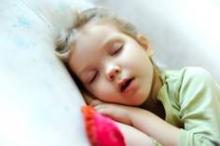MINNEAPOLIS – Tailoring an intervention to the particular needs of a child and his or her family can markedly improve the child’s ability to go to sleep and stay asleep, a pilot study shows.
The trial was successful enough that the National Institute of Child Health and Development has given the lead researcher, Michelle M. Garrison, Ph.D., of the Seattle Children’s Research Institute, funding to enroll 500 children in a randomized, controlled trial to validate the intervention.
Dr. Garrison undertook the pilot in part to see what would help sleep-deprived and frustrated parents, and pediatricians, who might not have a ready solution for a preschooler who persistently won’t go to bed or won’t stay in bed.
To recruit children for the study, Dr. Garrison sent the CSHQ (Children’s Sleep Habits Questionnaire) to parents of all children aged 2.5-5 years who had been seen at local pediatric clinics. If parents were interested, they returned the survey. If the children met the eligibility criteria for having a behavioral sleep problem, they were included. Not every parent agreed that their child had an issue, which created an initial hurdle for making the intervention work, said Dr. Garrison.
The program started with a home visit, in which parents received education and a kit that included a binder with educational handouts, the book
Take Charge of Your Child's Sleep (New York: Marlowe and Co., 2005), a bedtime routine chart with cards that can be individualized to the child, laminated passes that allow the child to step outside the routine occasionally, and a clock that glows green when it is okay to get out of bed in the morning.
Parents received three follow-up phone calls for education, to set goals, and to engage in preemptive problem solving. Parents were coached on setting bedtime routines, creating a consistent bedtime, eliminating screen time in the hour or two before bed, setting limits, and working on night waking.
The pilot enrolled 36 children with a mean age of about 4 years. Forty-four percent were female and 72% were white, 19% were Asian, 8% were black, and 6% were Hispanic. The race and ethnicity categories were not mutually exclusive, said Dr. Garrison. A total of 22% of children had been adopted after 1 year of age. The mean age of the parents was 38 years. Only 11% of children lived in a one-adult home, and 11% lived in a multigenerational home.
Sleep habits and issues were assessed at baseline and at 3 months through 7-day diaries, actigraphy, and several sleep scales. The researchers were able to perform actigraphy on only 15 children, but there was good concordance between those measures and the diaries, said Dr. Garrison.
Overall, on average, children slept an additional 36 minutes a night. According to the diaries, 14% slept 10-30 minutes more, a third slept 30-60 minutes more, and 25% slept an additional hour. The actigraphy showed that 14% of children gained 10-30 minutes sleep, 36% gained 30-60 minutes, and 7% gained more than an hour. The average onset latency decreased by 10 minutes.
Dr. Garrison said the intervention could be tailored to children and parents with varying needs. For instance, adopted and nonadopted children did equally well with the program. She and her colleagues also worked with co-sleepers. She split them into "reactive" co-sleepers – that is, parents who felt like they had no choice – and "lifestyle" co-sleepers, who saw it as a way to bond. Reactive co-sleepers were coached on getting children to sleep in their own beds. Lifestyle parents were taught how to get children to get to sleep first, before the adults joined them in bed. There was a significant increase in sleep duration in those children of lifestyle co-sleepers, said Dr. Garrison.
Overall, there were no differences observed by age, sex, or comorbid conditions such as asthma.
The things that seemed to help the most included the number of contacts with the families, the tailored bedtime routine, and anticipatory problem solving around bedtime consistency. Parents who were the most skeptical about the benefits of sleep benefited the most from the program, said Dr. Garrison.
She will now take her methods into a larger trial that is being funded by the NICHD and has begun enrolling children. It will include 500 children and families will get monthly phone follow-ups for 9 months. Children will be analyzed for 3 years, in part to see if improving sleep has any impact on body mass index, learning, and cognitive function, she said.


